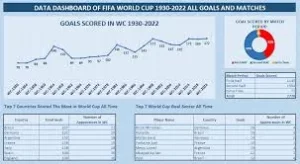The Fascinating World of World Cup Statistics
Soccer, also known as football, is the most popular sport in the world with an estimated 4 billion fans worldwide. And when it comes to soccer, there is no bigger stage than the FIFA World Cup. Held every four years, the World Cup brings together the best national teams from around the globe to compete for the ultimate prize in soccer.
As with any major sporting event, statistics play a crucial role in analyzing and understanding the game. From the number of goals scored to the distance covered by players, there is an endless supply of data to delve into. In this article, we will explore the world of World Cup statistics and take a deeper look at some of the most interesting and significant numbers from past tournaments.
Heading 1: The History of the FIFA World Cup

Before diving into the statistics, let’s take a brief look at the history of the FIFA World Cup. The first World Cup was held in 1930 in Uruguay, with only 13 teams participating. It was won by the host nation, and since then, the tournament has grown in popularity and size.
In 1950, the number of teams increased to 16, and by 1982, it had reached 24. The current format, with 32 teams, was introduced in 1998, and it remains unchanged today. The competition has been dominated by European and South American teams, with Brazil being the most successful nation, having won the tournament five times.
Subheading 1: The Most Successful Teams in World Cup History
With a total of 21 editions of the World Cup played, there have been only eight different winners. As mentioned earlier, Brazil has won the most titles with five, followed by Germany and Italy with four each. Argentina and Uruguay have two titles each, while England, France, and Spain have one each.
Brazil’s dominance can also be seen in the number of finals appearances, with the South American nation reaching the final on seven occasions. Germany and Argentina have both made it to the final five times, followed by Italy and the Netherlands with four each.
Subheading 2: Most Successful Players in World Cup History
Just like teams, there are some players who have made a significant impact in the history of the World Cup. The highest scorer in World Cup history is Miroslav Klose of Germany, with a total of 16 goals. He is followed by Brazil’s Ronaldo and Gerd Muller of Germany, who have scored 15 and 14 goals, respectively.
The record for the most World Cup appearances goes to Lothar Matthaus, who has played in five World Cups for Germany. In terms of goalkeeping, Oliver Kahn of Germany holds the record for the most clean sheets with 10.
Subheading 3: Interesting Facts about the World Cup
Apart from the records and statistics, there are some interesting facts about the FIFA World Cup that you may not be aware of. For example, the trophy awarded to the winners of the World Cup is not the original one. In 1966, the original Jules Rimet Trophy was stolen and never recovered. The current trophy, the FIFA World Cup Trophy, was introduced in 1974.
Another fascinating fact is that only two countries have ever declined to participate in the World Cup – India and Italy. Both nations withdrew from the tournament due to financial reasons. Additionally, the World Cup has only been held outside of Europe and South America twice – once in the United States in 1994 and once in South Africa in 2010.
Heading 2: Statistical Analysis of World Cup Matches

Now let’s move on to the more technical side of World Cup statistics – analyzing matches. There are numerous factors to consider when looking at the data from World Cup matches. We will take a closer look at some of the most important statistics and how they contribute to the outcome of a match.
Subheading 1: Goals Scored and Conceded
The most crucial statistic in any soccer match is, of course, the number of goals scored. In the history of the World Cup, there have been a total of 2,548 goals scored in 900 matches, giving an average of 2.83 goals per game. However, this number has been on the decline in recent years, with only 3.08 goals per game scored in the 2014 World Cup in Brazil.
When it comes to conceding goals, Brazilian goalkeeper Claudio Taffarel holds the record for the most goals conceded in World Cup history with 18. On the other hand, French goalkeeper Fabien Barthez has kept the most clean sheets with 10.
Subheading 2: Shots and Shots on Target
In a soccer match, the goal is to score as many goals as possible, and therefore, shots play a significant role. In the history of the World Cup, there have been a total of 74,376 shots attempted, with an overall accuracy of 33%. This means that only about one-third of the shots taken ended up on target.
Germany’s Thomas Muller holds the record for the most shots attempted in a single tournament, with 28 in the 2014 World Cup. However, he only managed to score five goals, giving him an accuracy rate of 18%. On the other hand, French striker Just Fontaine had the highest accuracy rate in a single World Cup, scoring 13 goals from just 23 shots in the 1958 tournament.
Subheading 3: Possession and Passes
Possession and passing statistics are used to measure a team’s control over the game. In the history of the World Cup, the team with the most possession has won 62% of the time. This shows that having more control over the ball can lead to a higher chance of winning.
In terms of passing, Spain holds the record for the most passes completed in a single tournament, with 4,955 passes completed in the 2010 World Cup. They also hold the record for the highest pass accuracy at 87%. These statistics highlight Spain’s style of play, which is based on maintaining possession and playing short, intricate passes.
Subheading 4: Distance Covered and Sprints
With soccer being such a physically demanding sport, distance covered and sprints are essential statistics to consider. In the 2018 World Cup, the average distance covered by a player was 11 kilometers per game, with France’s N’Golo Kante covering the most distance at 63.9 km throughout the tournament.
When it comes to sprints, Brazil’s Neymar Jr. holds the record for the most sprints in a single match, with 31 in the 2014 quarter-final against Colombia. This statistic highlights the speed and agility of the world’s top players and their ability to continuously run and sprint for 90 minutes.
Heading 3: Team Performance in the FIFA World Cup

Apart from individual match statistics, there are also team performance statistics that can give us insights into how a team performs in the World Cup. From the number of wins to the number of red cards received, there is a lot of data to analyze when it comes to team performance.
Subheading 1: Win Percentage and Win Streaks
Of the 21 World Cups that have been played so far, only eight different nations have lifted the trophy. This shows that winning the World Cup is not easy and requires a combination of talent and luck. However, some teams have performed better than others, and their win percentage reflects that.
Brazil has the highest win percentage in World Cup history, with a staggering 69.6%. This means that they have won almost seven out of every ten games they have played in the tournament. On the other hand, teams like New Zealand and Honduras have yet to win a game in the World Cup.
Subheading 2: Records and Milestones
Throughout the years, there have been some significant records and milestones achieved by teams in the World Cup. In terms of the most consecutive wins, Italy holds the record with 11 straight victories between 1934 and 1938.
The biggest win in World Cup history came in 2002 when Germany defeated Saudi Arabia 8-0 in the group stage. On the other hand, the biggest upset was in 1950 when the United States stunned England with a 1-0 victory in the group stage.
Subheading 3: Discipline and Red Cards
Apart from goals and wins, discipline is also an essential factor in a team’s performance. In the history of the World Cup, there have been a total of 345 red cards shown, with Argentina receiving the most at 26. The record for the most red cards in a single match goes to the Netherlands and Portugal, who both received four red cards in their round of 16 match in 2006.
On the other hand, Sweden and Switzerland hold the record for the fewest red cards received in World Cup history, with only one each. This shows that discipline and avoiding unnecessary fouls are vital in a team’s success in the tournament.
Heading 4: Individual Performances in the FIFA World Cup
While soccer is undoubtedly a team sport, there have been countless individual performances that have stood out in the history of the World Cup. These players have broken records, scored crucial goals, and led their teams to glory. Let’s take a closer look at some of the most memorable individual performances in the World Cup.
Subheading 1: Golden Boot Winners
As mentioned earlier, Miroslav Klose holds the record for the most goals scored in World Cup history. However, he has also won the Golden Boot award twice, first in 2006 and then in 2010. The award is given to the player who scores the most goals in a single tournament.
Other notable winners include France’s Just Fontaine, who scored 13 goals in the 1958 World Cup, and Brazil’s Ronaldo, who scored eight goals in the 2002 tournament. The highest-scoring Golden Boot winner is Colombia’s James Rodriguez, who scored six goals in the 2014 World Cup.
Subheading 2: Best Player Awards
Apart from the Golden Boot, there are other individual awards given out after each World Cup. The most coveted of these awards is the Golden Ball, which is given to the best player of the tournament. Some of the notable winners of this award include Argentina’s Diego Maradona in 1986 and Germany’s Franz Beckenbauer in 1974.
Another important award is the Golden Glove, given to the best goalkeeper of the tournament. The only goalkeeper to win it twice is Germany’s Oliver Kahn, who also holds the record for the most clean sheets in World Cup history.
Subheading 3: Memorable Performances
Apart from the official awards, there have been countless individual performances that have stood out in the World Cup. In 1982, Italian striker Paolo Rossi scored a hat-trick against Brazil in the group stage and then scored both goals in the semi-final against Poland. He then went on to score the opening goal in the final against West Germany, helping Italy lift the trophy.
In 1998, French midfielder Zinedine Zidane was instrumental in his team’s success, scoring two goals in the final against Brazil. And who can forget Diego Maradona’s famous “Hand of God” goal in 1986 and his incredible solo run against England in the same tournament?
Heading 5: The Impact of Statistics in Modern Soccer

With the advancement of technology and data analysis, statistics have become an integral part of modern soccer. From player recruitment to tactical decisions, there is no aspect of the game that is not influenced by statistics. Let’s take a closer look at how statistics are used in modern soccer.
Subheading 1: Player Recruitment and Performance Analysis
Gone are the days when player recruitment was based on gut feelings and personal opinions. Now, teams use complex statistical models to analyze players’ performances and identify potential signings. These models take into account various factors such as age, position, and playing style to determine a player’s value and potential.
In terms of performance analysis, teams use data collected from matches and training sessions to identify areas where players need improvement. This allows coaches to tailor their training sessions and tactics to get the best out of their players.
Subheading 2: Tactical Decisions and In-Game Analysis
During a match, coaches use real-time data to make tactical decisions and substitutions. For example, if a team is struggling to get shots on target, the coach may decide to bring on a more attacking player. Or if a player is getting tired, the coach can see his distance covered and sprints completed to determine whether it is time to make a substitution.
After the match, analysts dissect every aspect of the game, from passing accuracy to distance covered, to identify areas where the team can improve. This allows coaches to fine-tune their tactics and make adjustments for the next match.
Subheading 3: Fan Engagement and Fantasy Leagues
Lastly, statistics play a huge role in fan engagement and fantasy leagues. Fans can now access real-time data during matches, providing them with a deeper understanding of the game. This also allows fans to compare players’ performances and engage in debates about who is the best.
Fantasy leagues have also become increasingly popular, where fans create their own teams and compete against others based on players’ real-life performances. This adds an extra layer of excitement and competitiveness to watching soccer.
Heading 6: The Future of World Cup Statistics
As technology and data analysis continue to advance, we can expect to see even more intricate and detailed statistics in future World Cups. With the introduction of VAR (Video Assistant Referee) in the 2018 World Cup, we may see new statistics related to the use of video replays during matches.
Additionally, wearable technology such as GPS trackers and heart rate monitors may provide further insights into players’ physical performance during matches. This could potentially lead to changes in training methods and tactics to optimize players’ performance.
Conclusion
In conclusion, statistics play a crucial role in understanding and analyzing the FIFA World Cup. From team and individual performances to player recruitment and tactical decisions, there is no aspect of the game that is not influenced by statistics. As technology continues to advance, we can expect to see even more interesting and insightful statistics in future World Cups.
So the next time you watch a World Cup match, remember to pay attention to the numbers behind the game. Who knows, it may just give you a better understanding and appreciation of the beautiful game of soccer.













Post Comment